Incubating Crested Gecko Eggs – Step By Step Guide
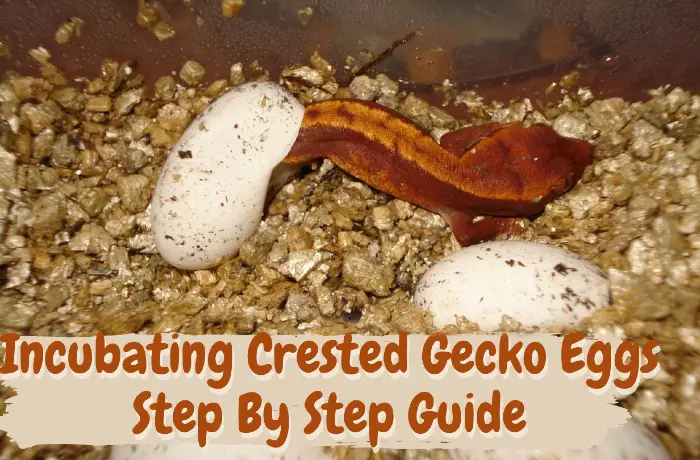
Knowing the process of incubating Crested gecko eggs is knowledge every owner must have. The good news is – incubating Crested gecko eggs is a fairly simple and straightforward process.
The steps in successful incubating of Crested gecko eggs include: marking the eggs, picking egg container, incubation medium and incubator, monitoring the progress of the eggs and finally the hatching!
It’s always better to be proactive and be prepared ahead of time. However, even if you are here researching information with newly laid eggs, don’t worry! The incubation process is pretty simple. Just follow the steps in this article.
Page Contents
Incubating Crested Gecko Eggs

Once the female Crested gecko has laid her eggs successfully in the nesting spot, the next steps you need to take are:
- Mark the eggs
- Pick an egg container
- Include incubation medium
- Incubator for the egg container
- Monitor incubation of the eggs
- Hatching
Incubating Crested gecko eggs is easy enough as long as you follow the steps mentioned above.
Marking The Eggs

Before excavating the eggs from the nesting spot, you need to mark each egg at the top whilst they are still laying in their original position. Important to note that you shouldn’t press too hard as the eggs are fragile and you can damage them!
The reason for marking the egg is to ensure you know what way is up and to always keep it that way. If you rotate or keep turning the egg, it can result in death of the embryo.
If you are breeding multiple geckos, you can write the date and the mother’s name on each shell. However, if you have eggs that are badly calcified, the shell is probably too bumpy and it’s not recommended to forcefully write on them. Instead, use a different mark such as a dot, star, cross for each batch to be able to differentiate them.
Egg Container
The second very important step in incubating Crested gecko eggs is choosing the egg container where the eggs will be kept during the incubation period.
For the Crested gecko eggs to be healthy and hatch successfully, you need to provide them with the right environment that promotes growth. You can choose from:
- DIY egg container
- Commercially bough egg container
DIY Homemade Containers
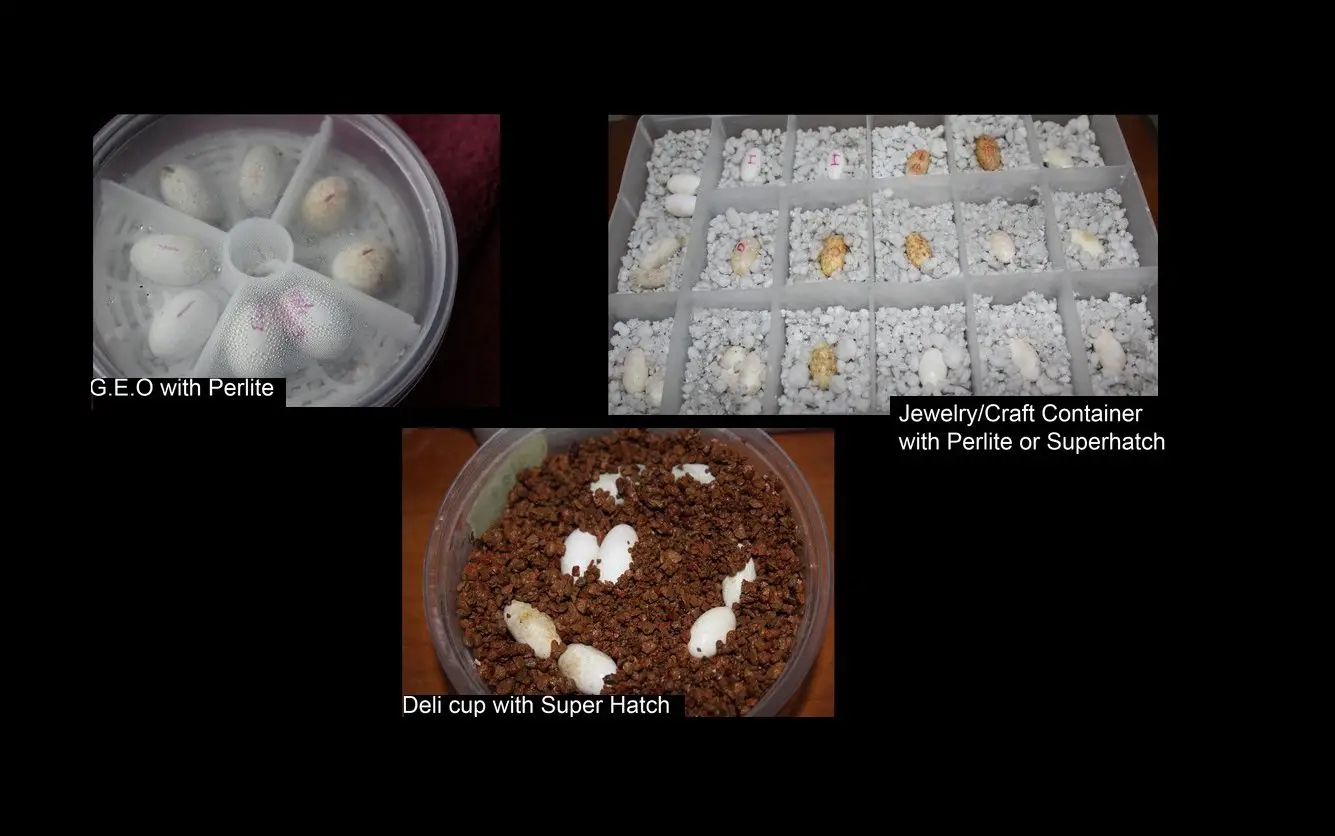
Finding something at your house to use as an egg container is surprisingly easy!
These some of the DIY egg containers that you can choose from:
- Plastic box such as Tupperware
- Deli cup
- Jewellery/Craft Container – this is especially good if you have many eggs to incubate
All you need for a DIY homemade egg container is:
- Size. The container should be minimum of 6 to 7 inches in diameter and 4 inches in height
- Ventilation. Ensure that you provide ventilation by poking up to 8 holes in the plastic box lid. The holes should be minimum of 1/8 inch in length
- Position the egg container should be in a cool and dark place
Commercial Egg Container
If you are not very much into DIY options, don’t worry! There are many options online or in store for egg containers starting from as little as $10.
Incubation Medium
The next step of incubating Crested gecko eggs is the incubation medium. This is the substance that the eggs lay directly in as they develop and the embryo grows inside.
The factors to consider when picking the incubation medium include:
- Ability to retain water
- Maintain humidity
- Sterile
- The material should not promote growth of mold or fungi
There are different choices for incubation medium that can be purchased either online or from a garden store such as:
- Hatchrite
- Vermiculite
- Perlite – It is best to use one part of perlite to 0.8g of water or make it 1:1
- Pangea hatch – this medium should be run underwater. Then, wait and see if it changes color. Finally, place it in a colander to remove the water
Instructions On Using Incubation Medium
Fill up 2/3 of the egg container with incubation medium of your choice. Then position the eggs 0.25 inches deep into the incubation medium.
As mentioned above, most mediums will need water to be added in. However, you should always read the instructions on the packaging beforehand.
Choosing An Incubator
Important step when incubating Crested gecko eggs is – the incubator. Once you have the egg container and the incubation medium that goes inside, you need to provide an incubator.
The perfect incubator is well-insulated and reduces the temperature fluctuations. In addition, you want an incubator that offers easy access to your eggs for visual inspections.
The incubator can be either:
- Commercial – purchased from the store or online, this is probably the safest and easiest option
- Homemade – DIY option are available also. However, more things can go wrong with that option
Commercial Incubator
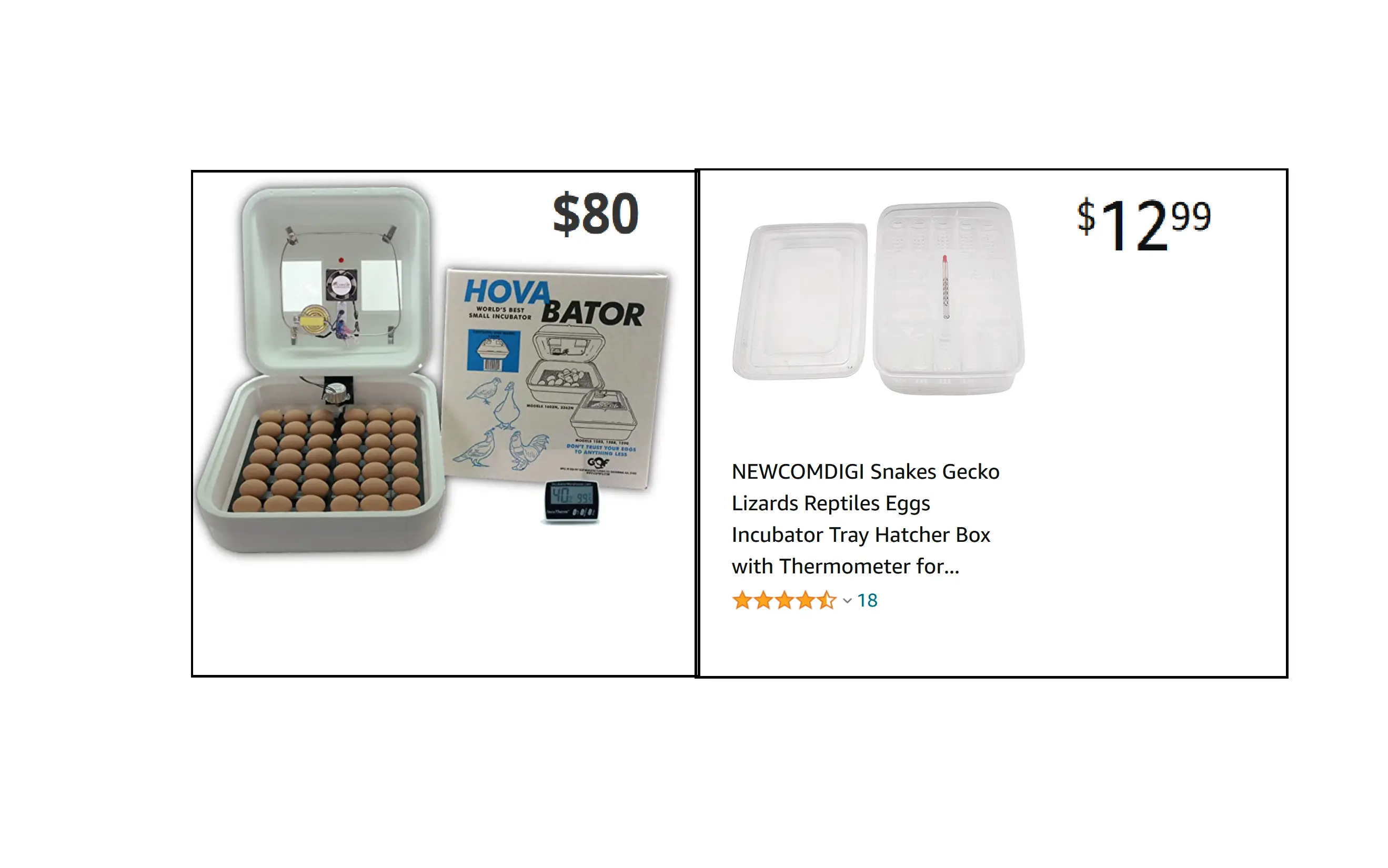
Commercial/Store bought incubator range from $12 for a simple incubation box to $216 for more advanced incubator (this is if you’re planning on continuous breeding)
If you are new to breeding, it’s recommended to purchase an incubator from a store or online. This way there is less chance of things going wrong.
Hovabators is a brand largely recommended online. Their incubators start from $80.
Homemade Incubator
On the other hand, there are options to make an incubator yourself using a 10-gallon aquarium/terrarium by following these steps:
- Add a few inches of water to the tank
- Use the aquarium’s heater to heat the tank to the needed temperature
- Add a brick in the water and place the egg container on top of it
- Cover the top of the tank. This is to keep the heat and moisture in the tank.
Incubator – Temperature And Humidity
When incubating Crested gecko eggs, you need to ensure that the temperature and humidity levels are correct. Inside and near the incubator.
The following is recommended for successful Crested gecko egg hatching:
- Temperature – 68oF to 80oF. It’s ok for the temperature to vary – a bit cooler in the evening and naturally rising during the day
- Humidity levels – 85% to 90%. You should try to maintain the same levels of humidity throughout
You will need a thermometer and hygrometer to track the temperature and humidity levels.
To learn more about looking after Crested gecko eggs click here Crested Gecko Egg Development (With Pictures)
Monitoring Incubation Of The Eggs
After you have set up the incubation environment for the Crested gecko eggs, now you’ll need to ensure that everything goes according to plan. This is done by checking on the progress of the eggs every few days.
In addition, when checking on the eggs and taking them out of the incubator, you will allow for air flow to get in which is beneficial.
During the incubation period, you need to be checking on the following:
- If the eggs are fertile. This is done through the use of the candling technique
- That there is no mould growing on the eggs
- Look for unhealthy eggs and try to improve their health
Are The Eggs Fertile – Candling Technique
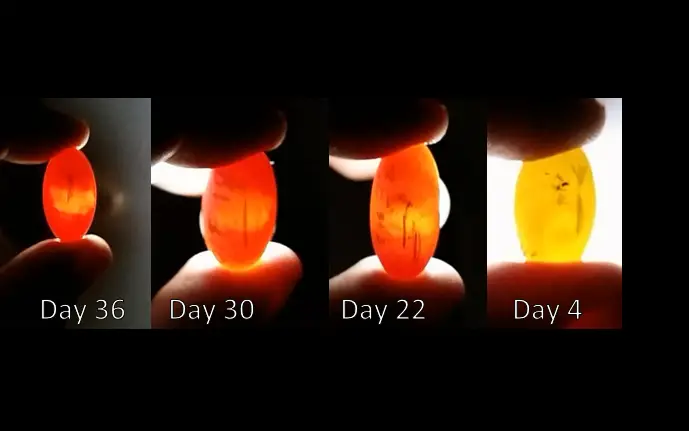
Once the eggs are in the incubation box, the best way to check on the progress and if the eggs are fertile, is through the use of the candling technique.
Candling is when you use a bright light to see through the semi-transparent shell of the egg. You can use the LED light on your smartphone to do this.
It’s recommended to first wash the eggs first by rinsing them off with cool water and gently removing the dirt with your fingers. However, be very careful as the eggs are slippery and avoid rotating them.
When checking on the progress of the eggs, look out for the following signs:
- Fertile egg – you’ll be able see red veins forming soon after the egg is laid
- Infertile egg – it doesn’t form veins and is only yellow on the inside. Even if you suspect the egg is infertile, you should not throw it away just in case it’s a late bloomer
Important part of incubating Crested gecko eggs is knowing what is the normal egg development. The more the embryo develops in the egg, the less light should be able to pass through the egg when using the candling technique to check on the progress.
Mold
Another important reason to check on the eggs is for any mold growing. With that said, if you do notice mold growing on the incubation medium, you should remove the eggs and wipe off the mold with a paper towel.
If you need to do this, ensure you’re not rolling the eggs over as that can be fatal for the embryos.
Unhealthy Eggs And Ways To Improve Health
Look for the following signs of an unhealthy Crested gecko eggs during your checks:
- White eggs turning brown – If the eggs start off white in color but then turn brown, it might mean they are going bad. However, you should continue to incubate the eggs as it’s hard to know for sure and there is still a chance of hatching
- Denting – Another possible sign of unhealthy egg is denting. This can be caused by lack of moisture and the egg drying out. To improve the health of the egg you can wash the egg gently, ensure the incubation medium is moist enough or place it in a new humid incubation box. This way it has a chance of recovering
- Swelling. If you notice the eggs’ shell swelling, it can lead to slowed down development. This normally occurs when the egg shells are poorly calcified because of absorbing too much water. A poorly calcified egg can become leathery and hard to hatch. In that case, observe the egg and when it’s close to hatching, help it get out. Only do this once the slit in the shell has been made
Incubating Crested Gecko Eggs – Last Stage – Hatching
The last stage and most exciting one is the hatching of the eggs. Normally, the eggs will start hatching anywhere from 45 days to 4-5 months. How long it takes depends on the temperature during the incubation period.
It’s recommended to incubate for at least 80 days. This creates a higher chance of the geckos having better crest and tail structure. To hatch the eggs in around 3 months, you should incubate at temperatures between 72oF and 75oF.
To learn more how to care for the hatchlings click here Baby Crested Gecko Care – The Ultimate Guide
Final Thoughts
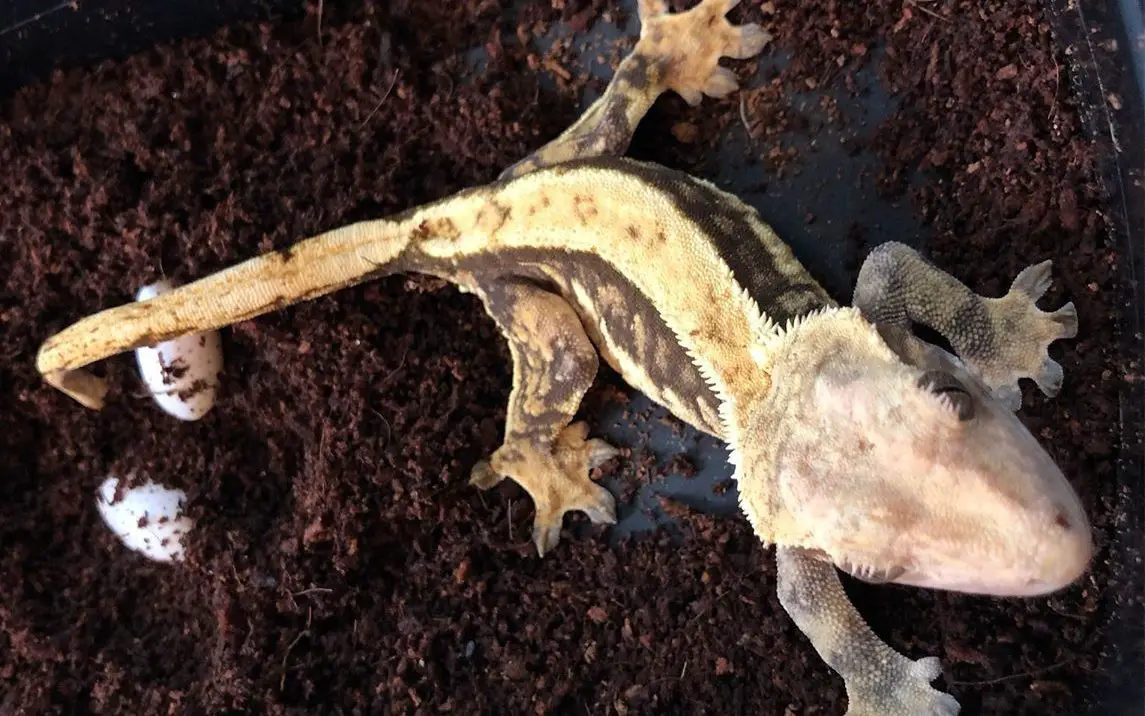
Incubating Crested geckos eggs is a simple and straightforward process even for novice breeders. As long as you follow the steps we discussed in this article and take care of the eggs whilst incubating, you should have a successful hatching.
The most important points to remember are the following:
- Marking the eggs. Once the eggs are laid, the top of the eggs should be marked whilst they are still in their original position in the nesting spot
- Egg container. This can be made from DIY materials such as Tupperware or bought from the store/online
- Incubation medium. Many mediums to choose from that can be bought online or from the store. The egg container should be filled 2/3 with the medium and the eggs should be places 0.25 inches deep in it
- Incubator. Although, there are DIY options, in this article we recommend to buy a commercial one
- Temperature and humidity levels should be at 68oF to 80oF and 85% to 90%. This needs to be tracked through the use of thermometer and hygrometer
- Monitoring the health of the eggs during incubation. Check on the eggs every few days by taking them out of the incubator. This way fresh air will reach the eggs and you’ll be able to check if the eggs are viable and if there is any mould growing that needs wiping off
- Hatching. The last stage and our end goal is the hatching. You should expect the hatching to start from 45 days to 4-5 months. This depends on the temperature during the incubation period. It’s recommended to incubate for at least 80 days
Although, incubating Crested gecko eggs is fairly easy, it should always be taken seriously. It’s the owner’s responsibility to provide the eggs with the right environment and conditions that will lead to successful hatchings and healthy geckos.
Related Questions
How Many Eggs Can You Incubate At A Time?
Multiple Crested Gecko Eggs Incubation
The number of crested geckos eggs that you can incubate at once is dependent on the incubator that you are using. Some good reptile incubators can accommodate only one egg, while some can accommodate up to 100 eggs at once.
However, female cresties will lay a clutch of two eggs every 30 to 45 days during a breeding season.
Can You Incubate Crested Gecko Eggs Without An Incubator?
Yes. You can incubate without an actual incubator. To use this method, you will have to maintain the optimum temperature needed for hatching in the room.
The temperature and humidity of the room needs to be as constant as possible. To track this you will need a thermometer and a hygrometer testing with a probe.
In addition, you will also need to mist the incubation medium and the eggs. This is because the moisture from the incubation medium will evaporate through the holes.
Can The Incubation Of The Eggs Affect The Gender Of The Geckos?
The gender of your gecko depends on the temperature and incubation period. If you incubate the eggs at a higher temperature (80oF to 84oF), you’ll end up with males babies. On the other hand, lower temperatures between 68oF to 73oF, will result in female baby geckos.



